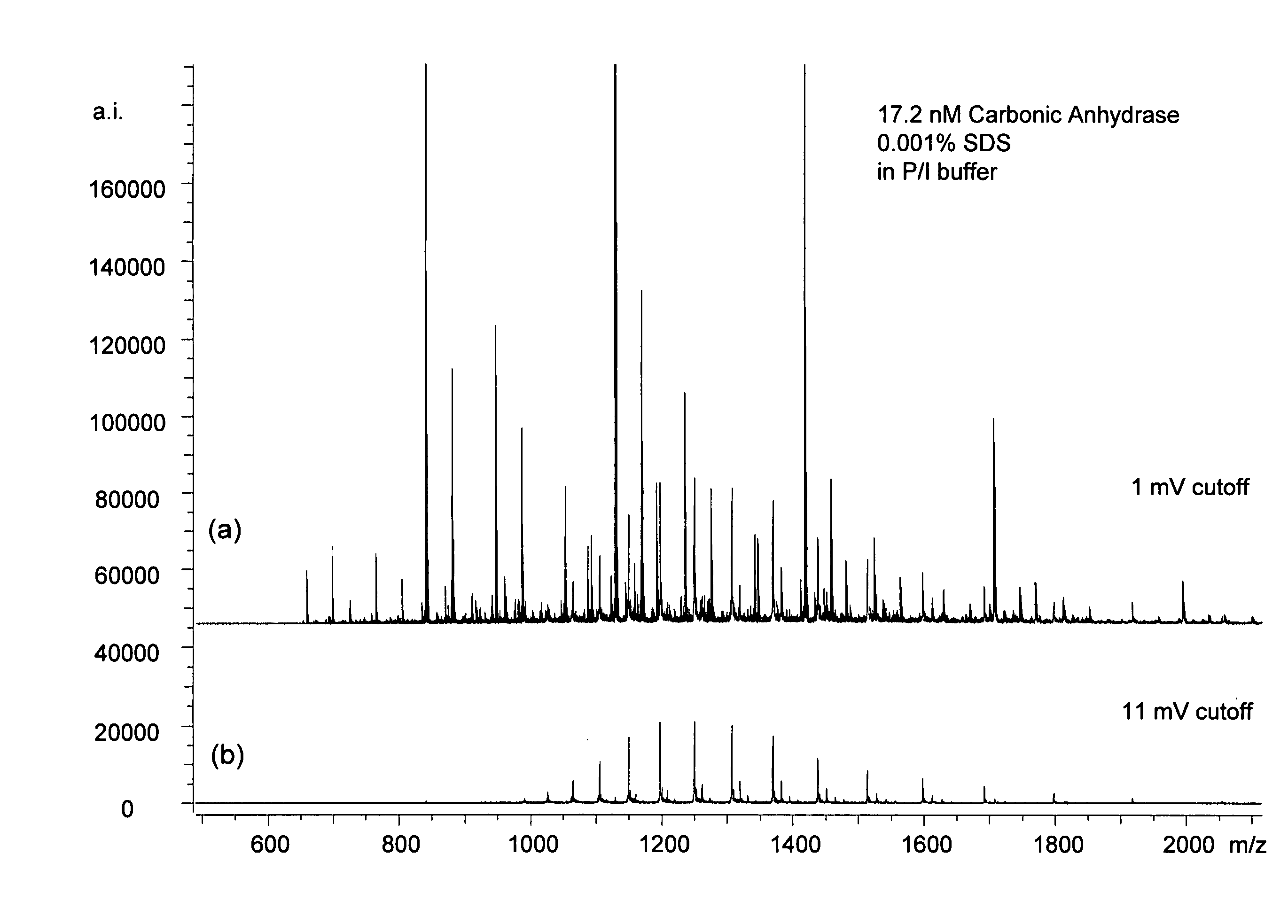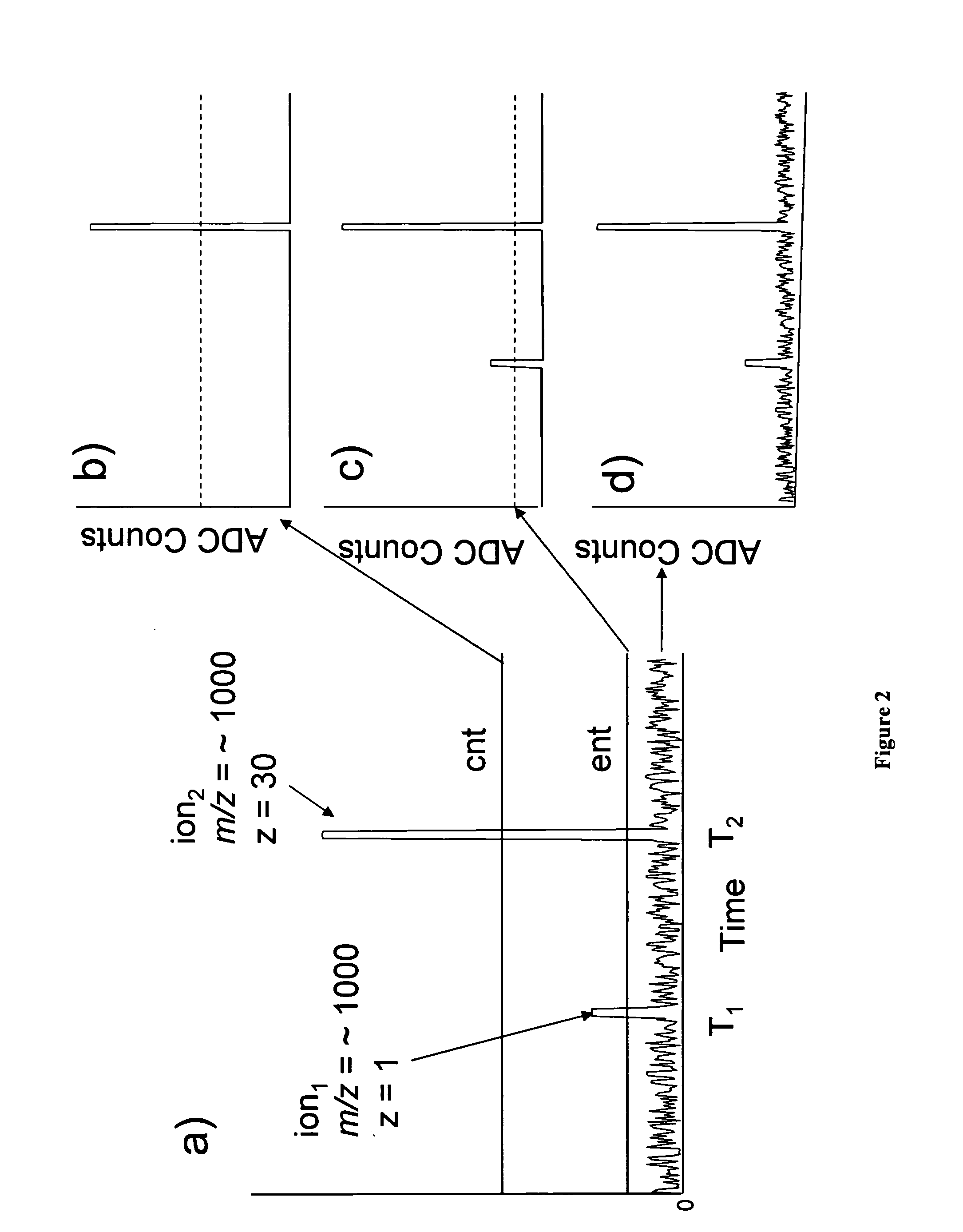Mass spectrometry with selective ion filtration by digital thresholding
- Summary
- Abstract
- Description
- Claims
- Application Information
AI Technical Summary
Benefits of technology
Problems solved by technology
Method used
Image
Examples
example 1
ESI-TOF Mass Spectrometry Conditions
[0029] A Bruker Daltonics (Billerica, Mass.) MicroTOF ESI time-of-flight (TOF) mass spectrometer was used in this work. Ions from the ESI source undergo orthogonal ion extraction and are focused in a reflectron prior to detection. Ions are formed in the standard MicroTOF ESI source which is equipped with an off-axis sprayer and glass capillary. For operation in the negative ion mode, the atmospheric pressure end of the glass capillary is biased at 6000 V relative to the ESI needle during data acquisition. A counter-current flow of dry N2 is employed to assist in the desolvation process. External ion accumulation is employed to improve ionization duty cycle during data acquisition. Each ESI-TOF spectrum is comprised of 75,000 data points digitized over 75 μs. All aspects of data acquisition were controlled by the Bruker MicroTOF software package. Post processing of data was also performed using the standard Bruker software.
example 2
PCR Conditions and Purification of Amplification Products
[0030] All PCR reactions were assembled in 50 μL reaction volumes in a 96 well microtiter plate format using a Packard MPII liquid handling robotic platform and M. J. Dyad thermocyclers (MJ research, Waltham, Mass.). The PCR reaction mix consists of 4 units of Amplitaq Gold, 1× buffer II (Applied Biosystems, Foster City, Calif.), 1.5 mM MgCl2, 0.4M betaine, 800 μM dNTP mix and 250 nM of primer. The following PCR conditions were used: 95° C. for 10 min followed by 50 cycles of 95° C. for 30 sec, 50° C. for 30 sec, and 72° C. for 30 sec.
[0031] PCR products were purified using the protocols disclosed and claimed in U.S. patent application Ser. No. 10 / 943,344 which is commonly owned and incorporated herein by reference in entirety.
example 3
Investigation of Detection Efficiency of Large Oligonucleotide Ions
[0032] In an attempt to optimize detection efficiency of large oligonucleotide ions, and to better understand the relationship between ion arrival statistics and mass accuracy, a detailed systematic study was designed to investigate detector response as a function of molecular weight, m / z, and charge state at the individual ion level.
[0033] In time of flight mass spectrometry ions are separated based on differences in their velocity as they traverse the flight tube. As ions strike the detector, their arrival times are recorded and subsequently converted to m / z based on the specific configuration of the spectrometer (length of flight path, accelerating voltage, geometry, etc.). It is generally accepted that for singly charged species, detector response is inversely proportional to molecular weight (velocity) and, for example in the case of MALDI, higher molecular weight species induce a smaller detection signal than...
PUM
 Login to View More
Login to View More Abstract
Description
Claims
Application Information
 Login to View More
Login to View More - R&D
- Intellectual Property
- Life Sciences
- Materials
- Tech Scout
- Unparalleled Data Quality
- Higher Quality Content
- 60% Fewer Hallucinations
Browse by: Latest US Patents, China's latest patents, Technical Efficacy Thesaurus, Application Domain, Technology Topic, Popular Technical Reports.
© 2025 PatSnap. All rights reserved.Legal|Privacy policy|Modern Slavery Act Transparency Statement|Sitemap|About US| Contact US: help@patsnap.com



